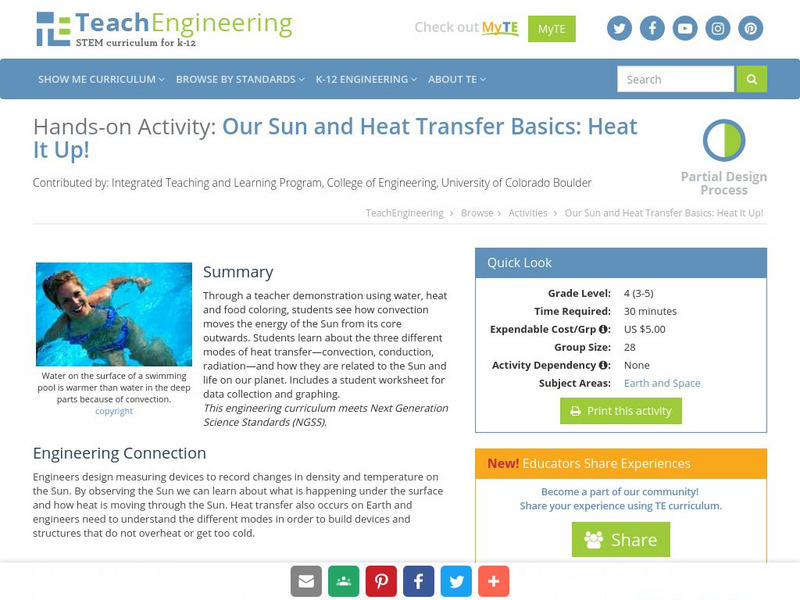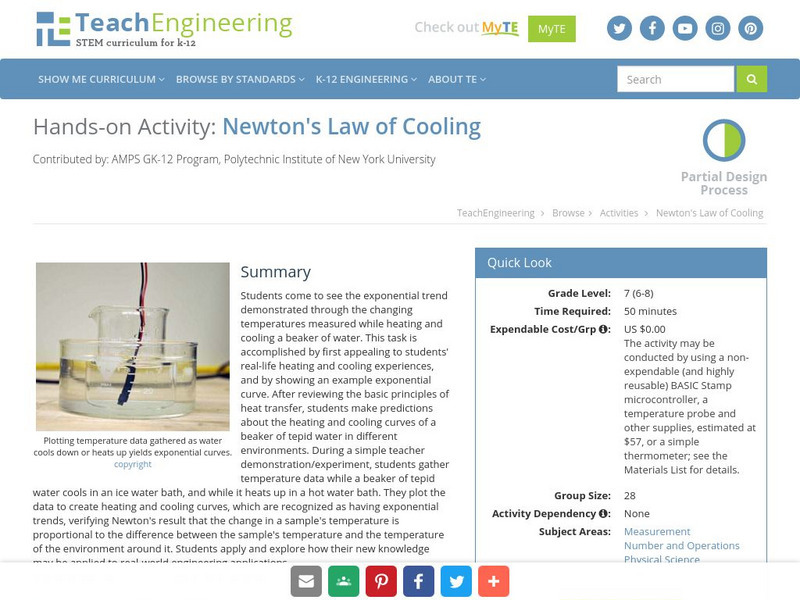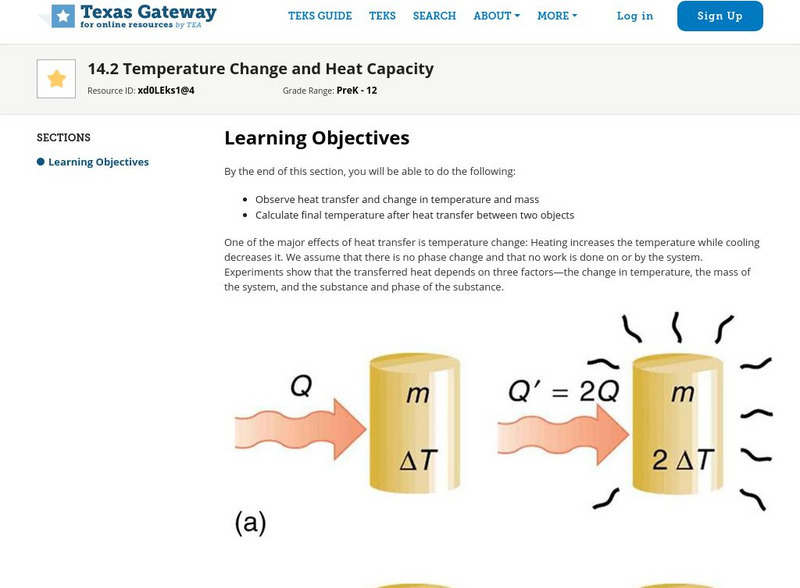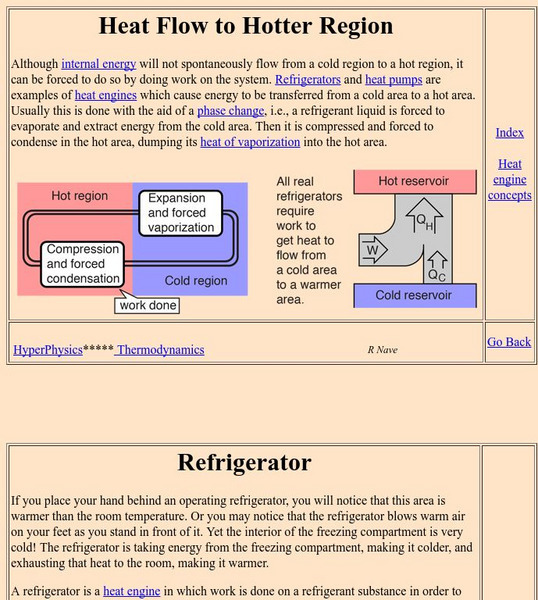TeachEngineering
Teach Engineering: Heat It Up!
Through a teacher demonstration using water, heat and food coloring, students see how convection moves the energy of the Sun from its core outwards. Students learn about the three different modes of heat transfer (convection, conduction,...
TeachEngineering
Teach Engineering: Newton's Law of Cooling
Students come to see the exponential trend demonstrated through the changing temperatures measured while heating and cooling a beaker of water. This task is accomplished by first appealing to students' real-life heating and cooling...
American Chemical Society
Middle School Chemistry: Heat, Temperature, and Conduction
Students observe, describe, and draw a model on the molecular level, showing how energy is transferred from one substance to another through conduction.
Texas Education Agency
Texas Gateway: Law of Conservation of Energy: Heat Transfer
Given illustrations, scenarios, descriptions, and/or diagrams, students will demonstrate understanding of heat transfer.
National Institute of Standards and Technology (NIST)
Thermophysical Properties of Fluid Systems
At this site, the student can find out thermophysical properties of different fluids and gases.
Physics Classroom
The Physics Classroom: Thermal Physics
A two-lesson tutorial on thermal energy in the study of physics. Lessons include informational text, interactive activities, animations, and quick, interactive comprehension check-ins.
Texas Education Agency
Texas Gateway: Heat and Heat Transfer Methods: Glossary
This is a glossary of terms and definitions used in Chapter 14: Heat and Heat Transfer Methods from the AP Physics online text.
Texas Education Agency
Texas Gateway: Heat and Heat Transfer Methods: Convection
By the end of this section, you will be able to discuss the method of heat transfer by convection.
Texas Education Agency
Texas Gateway: Phase Change and Latent Heat
By the end of this section, you will be able to examine heat transfer and calculate final temperature from heat transfer.
Texas Education Agency
Texas Gateway: Temperature Change and Heat Capacity
By the end of this section, you will be able to observe heat transfer and change in temperature and mass and to calculate final temperature after heat transfer between two objects.
Texas Education Agency
Texas Gateway: Heat and Heat Transfer Methods: Problems & Exercises
This is a list of 82 problems/exercises to solve based on the content of Chapter 14: Heat and Heat Transfer Methods from the AP Physics online text.
Texas Education Agency
Texas Gateway: Heat and Heat Transfer Methods: Conceptual Questions
This is a list of 26 questions covering the major concepts presented in Chapter 14: Heat and Heat Transfer Methods from the AP Physics online text.
PBS
Pbs Learning Media: Heat Transfer
In this interactive activity adapted from the Wisconsin Online Resource Center, students will learn how heat can be transferred in one of three ways: conduction, convection, and radiation.
Utah Education Network
Uen: Warm Me Up!
Identify misconceptions that many might have about heat sources.
Science Buddies
Science Buddies: Project Ideas: How Horses Keep Warm in the Wind
In this mammalian biology science fair project, students will learn about methods of heat transfer and determine the best direction in which horses should stand in a cold wind to maintain their core temperature. The Science Buddies...
CK-12 Foundation
Ck 12: Heat Transfer
Students explore the relationship between heat and energy transfer, and then describe how energy is transported through the processes of conduction, convection, and radiation. [Free Registration/Login may be required to access all...
Utah Education Network
Uen: Trb 3:5 Investigation 5 the Little Orange Rooster
Third graders will understand that heat energy can be produced by mechanical and electrical machines.
University Corporation for Atmospheric Research
Ucar: Atmosphere Images
Photos, diagrams, and other images related to climate and climate change.
PBS
Pbs Learning Media: Heat Transfer
Learn about thermal energy, also known as heat or heat energy, and the ways in which it can move from one object to another,
Discovery Education
Discovery Education: 3 M Young Scientist Lab: Too Hot to Handle
Can you design a handle for Hot Stuff's new skillet?
Georgia State University
Georgia State University: Hyper Physics: Heat Flow to Hotter Region
Heat flow from a hot region to a cold region is described and explained. Applications of this phenomenon (specifically heat pumps and refrigerators) are discussed. Excellent graphics.
Georgia State University
Georgia State University: Hyper Physics: Heat Engine Concepts: The Otto Cycle
Schematic diagrams illustrating the operation of a four-stroke engine cycle. Interactive buttons allow you to step through the various steps of each engine cycle. Each graphic is accompanied by an excellent explanation.
Georgia State University
Georgia State University: Hyper Physics: Heat Engine Concepts: Carnot Cycle
The Carnot cycle is described, illustrated and explained. The Carnot efficiency equation is given and interactive JavaScript form allows the visitor to investigate the effect of the reservoir temperature and the sink temperature upon the...
















